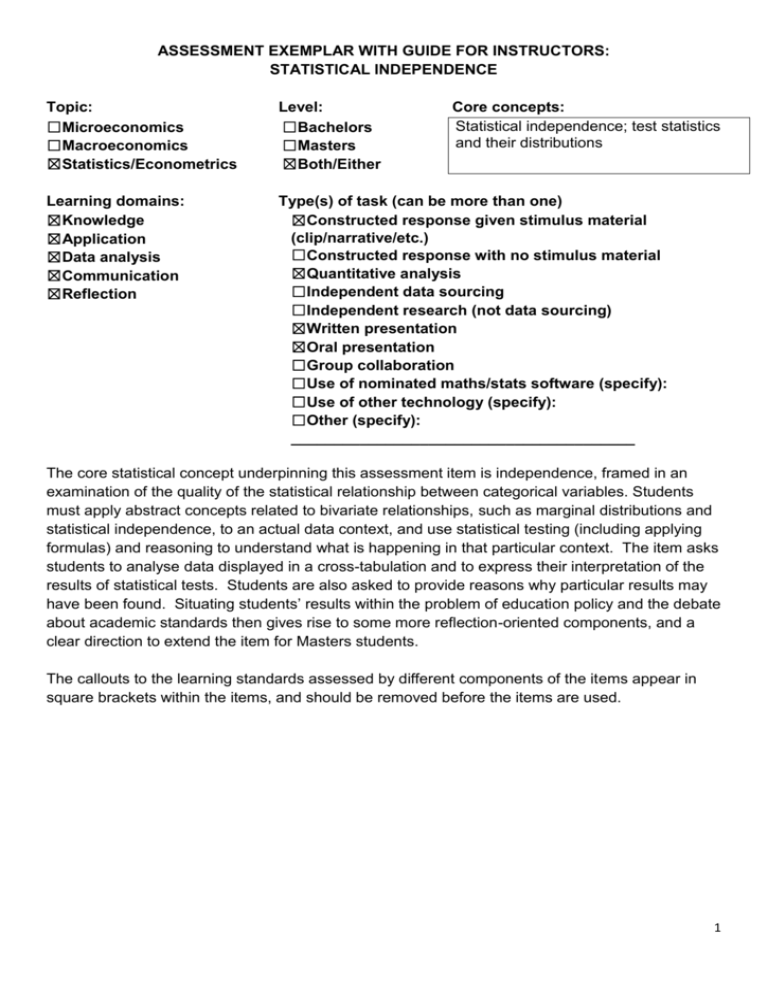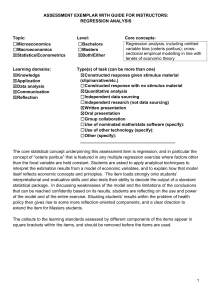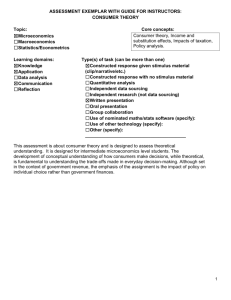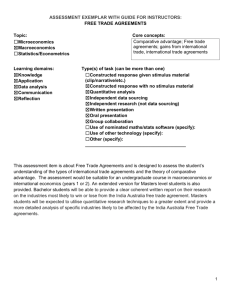Statistical independence - Economics Learning Standards
advertisement

ASSESSMENT EXEMPLAR WITH GUIDE FOR INSTRUCTORS:
STATISTICAL INDEPENDENCE
Topic:
☐Microeconomics
☐Macroeconomics
☒Statistics/Econometrics
Level:
☐Bachelors
☐Masters
☒Both/Either
Core concepts:
Statistical independence; test statistics
and their distributions
Learning domains:
☒Knowledge
☒Application
☒Data analysis
☒Communication
☒Reflection
Type(s) of task (can be more than one)
☒Constructed response given stimulus material
(clip/narrative/etc.)
☐Constructed response with no stimulus material
☒Quantitative analysis
☐Independent data sourcing
☐Independent research (not data sourcing)
☒Written presentation
☒Oral presentation
☐Group collaboration
☐Use of nominated maths/stats software (specify):
☐Use of other technology (specify):
☐Other (specify):
________________________________________
The core statistical concept underpinning this assessment item is independence, framed in an
examination of the quality of the statistical relationship between categorical variables. Students
must apply abstract concepts related to bivariate relationships, such as marginal distributions and
statistical independence, to an actual data context, and use statistical testing (including applying
formulas) and reasoning to understand what is happening in that particular context. The item asks
students to analyse data displayed in a cross-tabulation and to express their interpretation of the
results of statistical tests. Students are also asked to provide reasons why particular results may
have been found. Situating students’ results within the problem of education policy and the debate
about academic standards then gives rise to some more reflection-oriented components, and a
clear direction to extend the item for Masters students.
The callouts to the learning standards assessed by different components of the items appear in
square brackets within the items, and should be removed before the items are used.
1
Bachelors level task:
You have been contracted by the Head of the School of Basket-Weaving to perform some
statistical analysis in order to guide him in reviewing the School’s policies related to teaching and
learning.
You are provided with a data set capturing individual students’ grades in a course of 250 students
that used two different types of tutorials: Type A and Type B. The table below provides a
summary of this information.
Table 1: Basket-Weaving Students’ Results by Type of Tutorial
Fail
Pass
Credit
Distinction High
Distinction
Type A
13
59
26
6
1
Type B
12
71
39
19
4
TOTAL
25
130
65
25
5
i.
ii.
iii.
iv.
v.
vi.
vii.
TOTAL
105
145
250
What is the probability that a student chosen randomly from the class was allocated into a
Type {TYPE} tutorial and received at least a {GRADE} grade? [KB1,DB2]
Suppose that all {GRADE}-earning students are collected into one spreadsheet. What is the
probability that a student chosen at random from that spreadsheet was enrolled in a Type
{TYPE} tutorial? [KB1,DB2]
Are the events “being allocated into a Type B tutorial” and “receiving a Distinction grade”
independent events? Provide a justification for your answer. [KB1,DB2,CB1]
Suppose a formal test of the independence of tutorial type and grade is performed using
these data, and the null hypothesis of independence is rejected at the 5% level of
significance. (You do not have to do this test.) Give two possible reasons why the test
might have indicated a lack of independence. [RB1,CB1]
The Head of the School of Basket-Weaving is considering instituting a policy that all classes
in the School be graded according to a common grade distribution given by:
3% HD, 12% D, 25% C, 50% P, 10% F
Test whether the actual overall distribution of grades for the class you are analysing
complies with this distribution. Use a significance level of 1%. Be sure to state clearly your
hypothesis, decision rule and conclusion. [KB1,DB1, DB2]
What conclusions can you draw from your analysis about the potential effects of instituting
a common-grade-distribution policy across the entire School? [AB2,CB1]
What other information would you like to have in order to generate advice about the likely
School-wide effects of instituting a common-grade-distribution policy? What would you do
with this additional information in order to generate this advice? [AB2,RB2,CB1]
2
Masters level task:
You have been contracted by the Head of the School of Basket-Weaving to perform some
statistical analysis in order to guide him in reviewing the School’s policies related to teaching and
learning.
You are provided with a data set capturing individual students’ grades in a course of 250 students
that used two different types of tutorials: Type A and Type B. The table below provides a
summary of this information.
Table 1: Basket-Weaving Students’ Results by Type of Tutorial
Fail
Pass
Credit
Distinction High
Distinction
Type A
13
59
26
6
1
Type B
12
71
39
19
4
TOTAL
25
130
65
25
5
i.
ii.
iii.
iv.
v.
TOTAL
105
145
250
Are the events “being allocated into a Type B tutorial” and “receiving a Distinction grade”
independent events? Provide a statistical justification for your answer, and interpret what
your answer could mean in the context of the School’s teaching and learning practice in this
course. [KM1,DM2]
Suppose a formal test of the independence of tutorial type and grade is performed using
these data, and the null hypothesis of independence is rejected at the 5% level of
significance. (You do not have to do this test.) Give two possible reasons why the test
might have indicated a lack of independence. [RM1,CM1]
The Head of the School of Basket-Weaving is considering instituting a policy that all classes
in the School be graded according to a common grade distribution given by:
3% HD, 12% D, 25% C, 50% P, 10% F
Test whether the actual overall distribution of grades for the class you are analysing
complies with this distribution. Use a significance level of 1%. Be sure to state clearly your
hypothesis, decision rule and conclusion. What do your results imply about the effects of
implementing a similar common-grade-distribution policy across the entire School?
[KM1,DM1,DM2,CM1]
What other information would you like to have in order to generate advice about the likely
School-wide effects of instituting a common-grade-distribution policy? Why? What would
you do with this additional information in order to generate this advice?
[AM2,RM1,RM2,CM1]
In light of your knowledge of the Australian higher education sector, what costs and benefits
for students and for the university would you predict to arise in the long run if such a
common-grade-distribution policy were implemented across the sector? Are there any
ethical concerns with the implementation of this policy that you would point out as an
economist? Why or why not? [RM3,CM1]
3
Advice to assessors:
The type of communication used to express the answers to parts (vi) and (vii) in the Bachelors item
and parts (iii), (iv), and (v) in the Masters item can be written, which is the default, but could also be
oral. Masters students could use part (v) at the basis for a debate about Australian higher education
policy, possibly incorporating a collaborative component if debate preparation occurs within teams, or
a role-playing game where different students play the role of The Statistician, The Head of School,
the Vice-Chancellor, The Teacher, and The Student. Masters students could also be asked to
prepare reports on this same question for different audiences: one for consumption by the Head of
School or the Vice-Chancellor, and one for consumption by the Commonwealth Department of
Education, for example.
Masters students may be given reading material about the higher education sector in order to
respond knowledgably to part (v). Such material should be current and drawn from ongoing debates
on issues relating to academic standards (e.g., op-eds from The Australian or articles from The
Conversation), and could also include historical reports or articles about grade distributions in higher
education over time. For a further extension, they could be tasked with finding data sources that
could be used as input into statistical analyses that would help inform policy-setting in this area.
The question frame can be used as a graft for other questions that query students’ skills in evaluating
bivariate relations for purposes of education policy-setting – for example, an examination of the
student-level association between grades and lecture attendance, tutor, department, program of
study, or other discrete factors.
4
Learning
domain
Learning outcomes
Bachelor Degree
Masters Degree
Knowledge
KB1 Bachelor graduates will be able to
identify, coherently explain and synthesise
core economic concepts
KM1 Masters graduates will be able to
identify, coherently explain and synthesise
core and advanced economic concepts,
including recent developments in the
discipline
Application
Bachelor graduates will be able to:
Masters graduates will be able to:
AB1• frame problems in terms of core
economic concepts and principles
AM1• frame and critically analyse problems in
terms of core and advanced economic
concepts and principles
AB2• apply economic reasoning and
analytical skills, in order to make informed
judgments and decisions
AM2• apply advanced economic reasoning
and analytical skills, including quantitative
techniques where appropriate, in order to
make informed judgments and decisions
AM3• plan and execute a research-based
project
Data analysis
Bachelor graduates will be:
Masters graduates will be able to:
DB1• able to use economic data to address
typical problems faced by economists
DM1• select and apply an appropriate
empirical method to address typical problems
faced by economists
DB2• aware of, and able to implement,
basic empirical techniques and interpret the
results
DM2• critically evaluate the results
Communication CB1 Bachelor graduates will be able to
present a clear and coherent exposition of
economic knowledge, ideas and empirical
evidence both orally and in writing,
individually or in collaborative contexts
CM1 Masters graduates will be able to
communicate complex ideas clearly and
coherently, in written form and interactive oral
form to expert and non-expert audiences,
individually or in collaborative contexts
Reflection
Bachelor graduates will be able to reflect
on:
Masters graduates will be able to reflect on
and evaluate:
RB1• the nature and implications of
assumptions and value judgments in
economic analysis and policy
RM1• the nature and implications of
assumptions and value judgments in
economic analysis and policy
RB2• interactions between economic
thinking and economic events, both
historical and contemporary
RM2• interactions between economic thinking
and economic events, both historical and
contemporary
RB3• the responsibilities of economists and
their role in society
RM3• the responsibilities of economists and
their role in society
5









